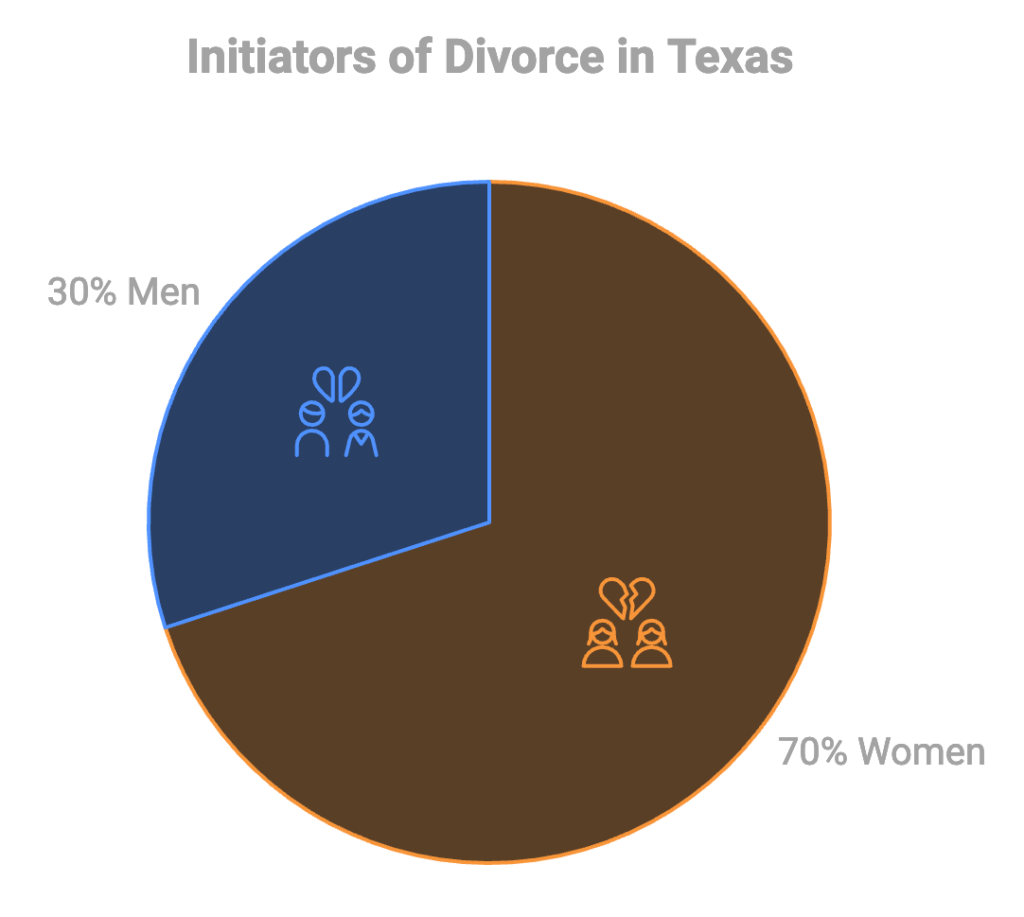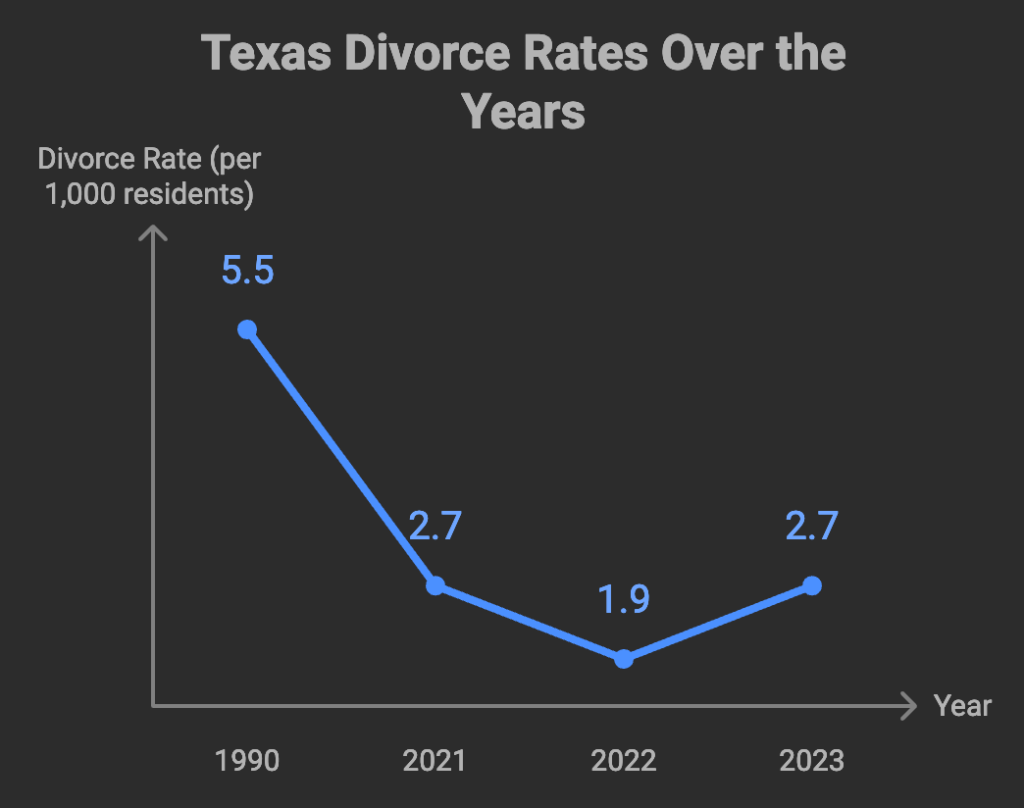Introduction
Welcome to the rollercoaster ride of Texas divorce statistics, where every twist and turn reveals surprising stories! In a state famous for its grand love stories and even grander weddings, it’s essential to peek behind the curtain. What’s happening with marriage in Texas? Are couples riding off into the sunset, or do they find themselves on a bumpy road to divorce?
Let’s sprinkle a bit of humor in here: if relationships were a country song, we’d probably hear a lot about heartache and breakups! Understanding Texas divorce trends can provide invaluable insights. This article will uncover the layers of data around divorce rates, reasons behind splits, and demographic influences. Are you contemplating your own divorce? Or perhaps you’re just a curious heart wondering about love in Texas? Either way, grab your cowboy hat and let’s saddle up for a data-driven journey!
As we dig into the numbers, you’ll discover that Texas has a unique marital landscape. The current divorce rate is approximately 2.7 per 1,000 residents, echoing a gradual decline over the years. For a state with a population of nearly 30 million, that still translates to a significant number of heartbroken couples. But don’t let the stats fool you; Texas is not all bad news.
The Lone Star State also boasts a rich tapestry of cultural and social influences shaping its marriage and divorce dynamics. From the bustling cities to quiet towns, every corner of Texas has a story to tell. This comprehensive guide will walk you through the ins and outs of Texas divorce statistics, combining humor and facts to keep you engaged. So, let’s lace up our boots and get ready to explore the fascinating statistics behind divorce in Texas!

Summary of Key Points
1. Current Divorce Rate: As of 2023, Texas’ divorce rate stands at approximately 2.7 per 1,000 residents, reflecting a gradual decline over the years.
2. Comparison with National Rates: Texas generally has a lower divorce rate compared to the national average, which hovers around 3.2 per 1,000 residents.
3. Who Initiates Divorce: Approximately 70% of divorces in Texas are initiated by women, shedding light on social dynamics and financial independence.
4. Common Reasons for Divorce: Major factors include communication problems, financial stress, and infidelity, with a significant number of divorces involving children.
5. Impact of Education and Age: Higher education correlates with lower divorce rates, and younger couples face greater risks compared to those who marry later.
6. County-Specific Trends: Variations in divorce rates exist across Texas counties, with urban areas generally reporting higher rates.
7. Cultural Influences: Texas’ diverse cultural background affects marriage and divorce rates, with religious couples showing lower divorce rates.

Understanding Texas Divorce Rates
What is the Divorce Rate in Texas?
As of 2023, Texas holds a divorce rate of approximately 2.7 per 1,000 residents. This figure reflects a gradual decline compared to the past. For instance, in 1990, the divorce rate hit a staggering 5.5 per 1,000. According to the Centers for Disease Control and Prevention (CDC), this downward trend indicates a significant change in Texas marital dynamics.
In 2021, the state recorded around 40,600 divorces, a notable number given its population of nearly 30 million. Meanwhile, the Texas Department of State Health Services (DSHS) provides additional insights, showing a divorce rate of about 1.9 per 1,000 people in 2022. This data highlights that while the divorce rate is decreasing, countless individuals still face the complexities of marital dissolution each year.

To better navigate these complexities, consider picking up The Divorce Recovery Workbook. It’s a fantastic resource that guides you through the emotional and practical aspects of divorce, helping you reclaim your happiness one page at a time!
National Comparison
When comparing Texas to national statistics, the Lone Star State generally boasts a lower divorce rate. The national average hovers around 3.2 per 1,000 residents. So, what gives Texas its edge? One possible explanation lies in the diverse cultural and social influences that shape its population. Texas is home to a mix of religious communities, many of whom emphasize the importance of marriage and, consequently, may experience lower divorce rates.
Moreover, economic factors play a role. The state’s booming economy provides financial stability, which can alleviate one of the significant stressors in marriages—money. As couples navigate financial hurdles together, harmony can often be maintained. However, this isn’t a universal truth, as some couples may still face financial strain, leading to potential marital breakdowns.

If you’re looking for ways to improve your relationship, consider reading The 5 Love Languages by Gary Chapman. This book can help you understand your partner’s needs and foster deeper connections, making it less likely for those pesky divorce papers to come knocking!
Demographic Influences on Divorce Rates
Several demographic factors influence divorce likelihood in Texas. Age, education, and income significantly contribute to marital stability. Research indicates that younger couples are more prone to divorce. In Texas, the average age for women marrying for the first time is around 27, while men typically marry at 29. Marrying young often correlates with higher divorce rates, as couples may lack the maturity and experience needed to navigate challenges effectively.
Education also plays a crucial role. Those with higher education levels tend to experience lower divorce rates. In fact, individuals holding a college degree are less likely to end their marriages than those without. Financial stability, which often comes with education, can reduce stress and foster a more supportive marital environment.

Speaking of education, if you’re interested in exploring emotional connections more deeply, check out Hold Me Tight by Dr. Sue Johnson. It’s a fantastic guide to understanding emotional responses and improving relationship dynamics!
Income levels further influence divorce trends. Couples with lower incomes tend to experience higher rates of divorce, likely due to financial stressors. Conflicts arising from budgeting, spending habits, and financial expectations can ignite tensions in relationships. Conversely, couples with higher incomes often enjoy greater stability and resources, which can help maintain their marriage.
In summary, understanding Texas divorce rates reveals a complex interplay of factors. The current rate of 2.7 per 1,000 residents, when examined alongside national averages and demographic influences, paints a vivid picture of marital dynamics in the Lone Star State. With changing societal attitudes, economic stability, and education, the landscape of marriage in Texas continues to evolve, making it an essential topic for anyone interested in understanding relationship trends in the state.

The Impact of Children on Divorce
When couples decide to part ways, having children can significantly influence their decisions and outcomes. The presence of kids often complicates the divorce process, transforming it into a tangled web of emotions and logistics.
In Texas, nearly half of all divorces involve children under 18 years old. This statistic highlights that many parents must navigate the murky waters of custody arrangements. A crucial question arises: who gets the kids? In most cases, women are granted custody, with around 43% of mothers receiving primary guardianship after divorce. Meanwhile, only about 19% of fathers take on this role.
These custody stats can lead to heated negotiations and emotional upheaval. Parents often experience anxiety over visitation schedules and financial responsibilities like child support. The stakes are high, and the impact on children can be profound. Kids might struggle with emotional distress, academic performance, and behavioral issues.
Understanding how children affect divorce decisions can be eye-opening. Parents are often torn between their desire for personal happiness and the well-being of their kids. Ultimately, the journey through divorce can be complex, but it’s vital to prioritize the little ones at the heart of it all.

To help navigate this challenging time, consider reading The Truth About Children and Divorce by Robert E. Emery. It’s a crucial resource for parents trying to make sense of the emotional landscape during divorce.
Trends Over the Years
Historical Data on Divorce Rates
Divorce rates in Texas have shifted over the decades, reflecting broader societal changes. In the early 1990s, the state saw a peak divorce rate of 5.5 per 1,000 residents. Fast forward to recent years, and that number has dropped significantly. The latest statistics show a rate of approximately 2.7 per 1,000 residents in 2023, suggesting that couples are increasingly finding ways to work through their differences.
What’s behind this decline? Several factors come into play. First, societal attitudes toward marriage and divorce have evolved. Fewer people view marriage as a rite of passage, leading to a decrease in hasty unions that often end in divorce. Additionally, increased access to marriage counseling and mediation services means couples have more resources to address their issues before calling it quits.

The rise of the internet also plays a role. Couples can access valuable information on relationship dynamics, helping them navigate tough patches. This surge in knowledge equips individuals with better tools for communication and conflict resolution.
To further enhance your understanding of relationships, you might want to check out Attached by Amir Levine. This book dives into attachment styles and their influence on relationships, making it a must-read for anyone seeking deeper connections!
County-Specific Trends
Divorce rates can vary significantly across Texas counties, creating a patchwork of marital dynamics. For instance, Dallas County consistently reports higher divorce rates compared to the state average, while counties like Travis, which includes Austin, tend to fare better.
In 2021, Johnson County led with a staggering divorce rate of 12.1%, while Fort Bend County reported the lowest at just 7.1%. Factors for these disparities can range from economic conditions to cultural influences. Urban areas often face unique challenges, such as higher living costs and faster-paced lifestyles, which can strain relationships.

In contrast, rural counties may exhibit lower rates due to stronger community ties and traditional values surrounding marriage. Understanding these county-specific trends can provide valuable insights into the complexities of marriage and divorce in Texas.
By examining both historical data and county-specific trends, we gain a clearer picture of the evolving landscape of divorce in the Lone Star State. It’s a journey marked by societal shifts, changing attitudes, and the nuanced realities of relationships across diverse regions.

Conclusion
Understanding Texas divorce statistics is crucial for anyone wanting to grasp the complexities of marital relationships in the Lone Star State. These numbers tell a compelling tale, weaving together themes of love, loss, and resilience. From the historical context to present-day trends, the statistics provide insights into the evolving nature of marriage in Texas.
Over the years, the divorce rate in Texas has shown a decline. From a high of 5.5 divorces per 1,000 residents in 1990, the current rate is approximately 2.7. This gradual decline reflects changing societal attitudes toward marriage, where fewer couples view it as a necessity. Instead, many now consider it a choice, leading to more thoughtful decisions about entering and exiting marriages.
Additionally, the dynamics of who initiates divorce have shifted. Women now file for approximately 70% of divorces in Texas, showcasing greater financial independence and societal changes. This shift emphasizes the need for a deeper understanding of the motivations behind marital breakdowns.
Common reasons for divorce, such as communication issues, financial stress, and infidelity, highlight the challenges couples face. Interestingly, higher education levels correlate with lower divorce rates, suggesting that informed individuals may navigate relationship challenges more effectively.
County-specific trends reveal that divorce rates can vary widely across Texas. Urban areas often report higher rates compared to rural counties, reflecting the unique pressures faced by couples in different environments.

As marriage continues to evolve, ongoing research will provide deeper insights into the factors that shape relationships in Texas. Understanding these trends can help couples navigate their own relationships better, fostering healthier connections.
In conclusion, Texas divorce statistics offer more than just numbers; they reveal the intricate dance of relationships in a state rich with cultural diversity and changing social norms. By keeping an eye on these trends, we gain a clearer understanding of what shapes love and partnerships in the Lone Star State.
FAQs
What is the current divorce rate in Texas?
The current divorce rate in Texas is approximately 2.7 per 1,000 residents. This figure reflects a gradual decline over the years, illustrating changing societal views on marriage.
Who initiates divorce more often in Texas?
Women initiate about 70% of divorces in Texas. This trend highlights evolving social dynamics and greater financial independence for women, allowing them to make choices that prioritize their well-being.
What are the most common reasons for divorce?
Common reasons for divorce in Texas include communication problems, financial issues, and infidelity. These factors often create significant stress in relationships, leading couples to seek separation.
How does education affect divorce rates?
Higher education levels correlate with lower divorce rates in Texas. Individuals with college degrees tend to have better communication skills and financial stability, which can contribute to healthier relationships.
Are divorce rates the same across Texas counties?
No, divorce rates vary significantly from one county to another. Urban areas often report higher rates, while rural counties may experience lower divorce rates due to stronger community ties and cultural influences.
What impact do children have on divorce?
Nearly half of all divorces in Texas involve children. This can complicate divorce proceedings, especially regarding custody arrangements and financial responsibilities, making it essential for parents to prioritize their children’s well-being.
Please let us know what you think about our content by leaving a comment down below!
Thank you for reading till here 🙂
All images from Pexels




